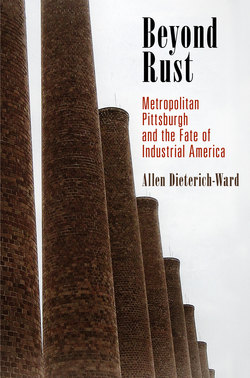Beyond Rust

Реклама. ООО «ЛитРес», ИНН: 7719571260.
Оглавление
Allen Dieterich-Ward. Beyond Rust
Отрывок из книги
BEYOND RUST
Series Editors: Margot Canaday, Glenda Gilmore, Michael Kazin, Stephen Pitti, Thomas J. Sugrue
.....
Following the collapse of the Renaissance partnership in the early 1970s, the struggle of business leaders, executives at non-profit organizations, and municipal officials to deal with changing local, state, and federal attitudes toward urban renewal made Pittsburgh an important laboratory for public policy innovation. Between his election as the city’s mayor in 1969 and his selection as deputy attorney general by President Carter in 1977, Peter Flaherty severed institutional connections with the Allegheny Conference, scaled back urban renewal projects, and directed a larger portion of municipal spending away from downtown. Faced with dramatic cuts to federal spending on aid to cities, Flaherty set the standard for a new wave of fiscal populism among liberal Democratic mayors through cost-saving measures, the elimination of public sector jobs, the reduction of some city services, and an increased reliance on community-based organizations that would play a pivotal role in subsequent urban development. Outside city government, a partnership between conservative philanthropist Richard Mellon Scaife and the nonprofit Pittsburgh History and Landmarks Foundation led to the creation of Station Square, a festival marketplace designed to showcase the economic viability of a privately financed, heritage-based commercial district.18
Out of this context, a revived public-private coalition gradually emerged, based on a pragmatic model for growth that adapted the earlier Mellon-Lawrence partnership to fit the changing political landscape of the 1980s and 1990s. In his last year in office before leaving for Washington, D.C., Flaherty’s stance toward the Allegheny Conference softened considerably as his staff sought ways to encourage the expansion of university-related employment and cautiously advocated the selective use of eminent domain to assemble land for commercial uses. The subsequent administration of Richard Caliguiri (1977–1988) embraced these priorities and launched a major downtown revitalization program dubbed Renaissance II. Unlike the top-down decision-making of the postwar era, however, fiscal constraints on both the government and corporate sides forced the inclusion of a broader range of voices and required that the city’s primary role in urban development be in arranging incentives, such as tax increment financing, to private investors. The success of Station Square and its symbolic inclusion in Renaissance II also highlighted the increasing role of foundations and community development corporations (CDCs) not only in funding projects but also in conceiving and nurturing new approaches to urban development that relied less on direct government oversight, overt public financing, and the use of eminent domain.19
.....